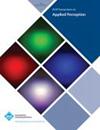探索在虚拟环境中导航时,身体位置和运动方法对存在感和晕动病的相对影响
IF 2.1
4区 计算机科学
Q3 COMPUTER SCIENCE, SOFTWARE ENGINEERING
引用次数: 0
摘要
本研究的主要目的是加强对在虚拟环境(VE)中导航时与身体位置和运动方法相关的存在和晕动病的机制的理解。在这方面,我们比较了两种身体姿势(站立和坐着)和四种运动方式(转向+具身控制[EC],转向+工具控制[IC],隐形传态+ EC和隐形传态+ IC),以研究VR中身体姿势,运动方式,存在和晕动病之间的关系。双向方差分析结果显示,运动方式对存在感有主要影响,驾驶+ IC条件的存在感显著降低。然而,体位对在场感没有主要影响,体位与运动方式之间也没有交互作用。对于晕动病,由于非正态性,使用了非参数测试。曼-惠特尼U测试的结果显示,体位对晕屏有显著的统计学影响。特别是,站着的晕机程度明显高于坐着的晕机程度。此外,Kruskal-Wallis测试的结果显示,运动方法对晕机有显著的影响,驾驶条件下的参与者比传送条件下的参与者感到更强烈的晕机症状。总的来说,这项研究证实了在驾驶VE时身体位置、运动方式、存在感和晕动病之间的关系。本文章由计算机程序翻译,如有差异,请以英文原文为准。
Exploring the Relative Effects of Body Position and Locomotion Method on Presence and Cybersickness when Navigating a Virtual Environment
The primary goals of this research are to strengthen the understanding of the mechanisms underlying presence and cybersickness in relation to the body position and locomotion method when navigating a virtual environment (VE). In this regard, we compared two body positions (standing and sitting) and four locomotion methods (steering + embodied control [EC], steering + instrumental control [IC], teleportation + EC, and teleportation + IC) to examine the association between body position, locomotion method, presence, and cybersickness in VR. The results of a two-way ANOVA revealed a main effect for locomotion method on presence, with the sense of presence significantly lower for the steering + IC condition. However, there was no main effect for body position on presence, nor was there an interaction between body position and locomotion method. For cybersickness, nonparametric tests were used due to non-normality. The results of Mann-Whitney U tests indicated a statistically significant effect of body position on cybersickness. In particular, the level of cybersickness was significantly higher for a standing position than for a sitting position. In addition, the results of Kruskal-Wallis tests revealed that the locomotion method had a meaningful effect on cybersickness, with participants in the steering conditions feeling stronger symptoms of cybersickness than those in the teleportation conditions. Overall, this study confirmed the relationship between body position, locomotion method, presence, and cybersickness when navigating a VE.
求助全文
通过发布文献求助,成功后即可免费获取论文全文。
去求助
来源期刊

ACM Transactions on Applied Perception
工程技术-计算机:软件工程
CiteScore
3.70
自引率
0.00%
发文量
22
审稿时长
12 months
期刊介绍:
ACM Transactions on Applied Perception (TAP) aims to strengthen the synergy between computer science and psychology/perception by publishing top quality papers that help to unify research in these fields.
The journal publishes inter-disciplinary research of significant and lasting value in any topic area that spans both Computer Science and Perceptual Psychology. All papers must incorporate both perceptual and computer science components.
 求助内容:
求助内容: 应助结果提醒方式:
应助结果提醒方式:


